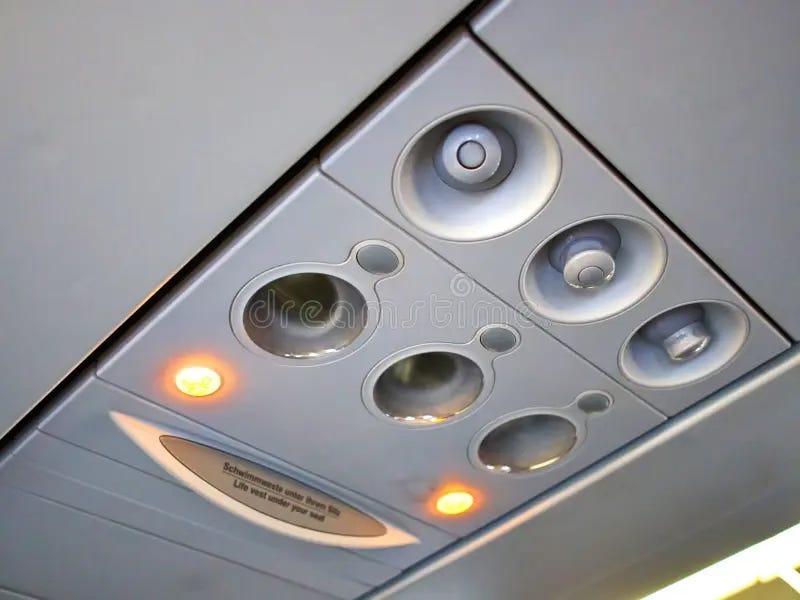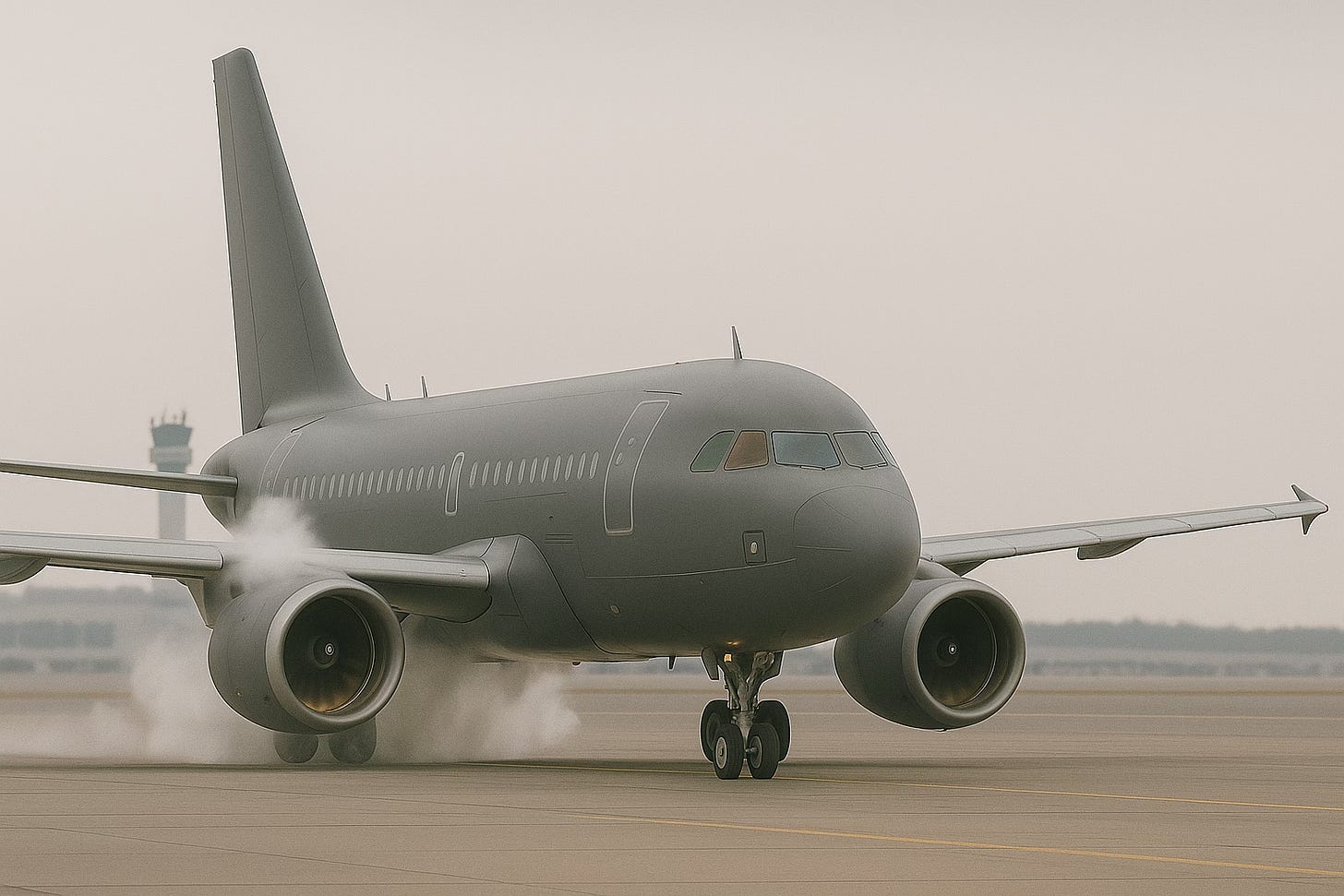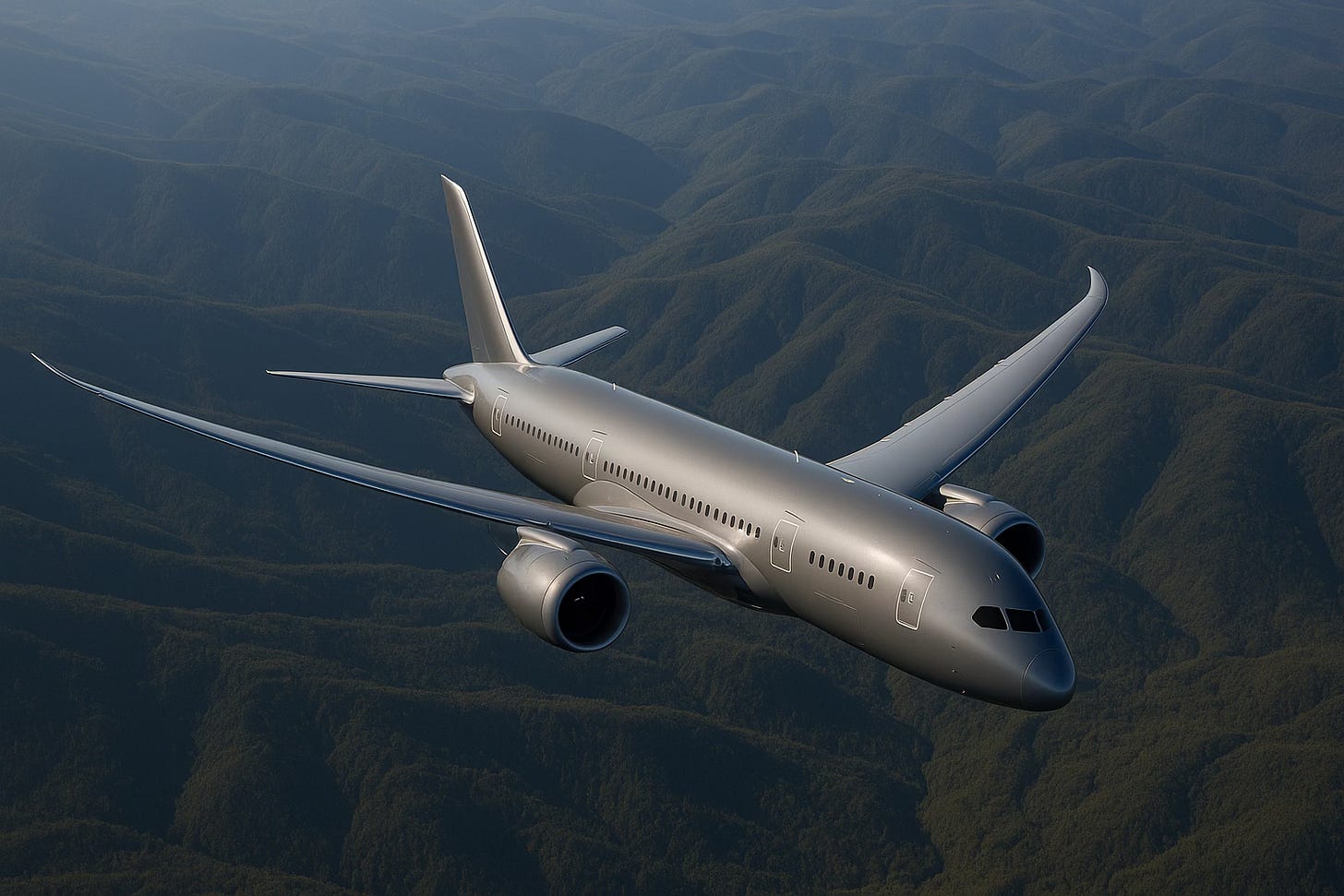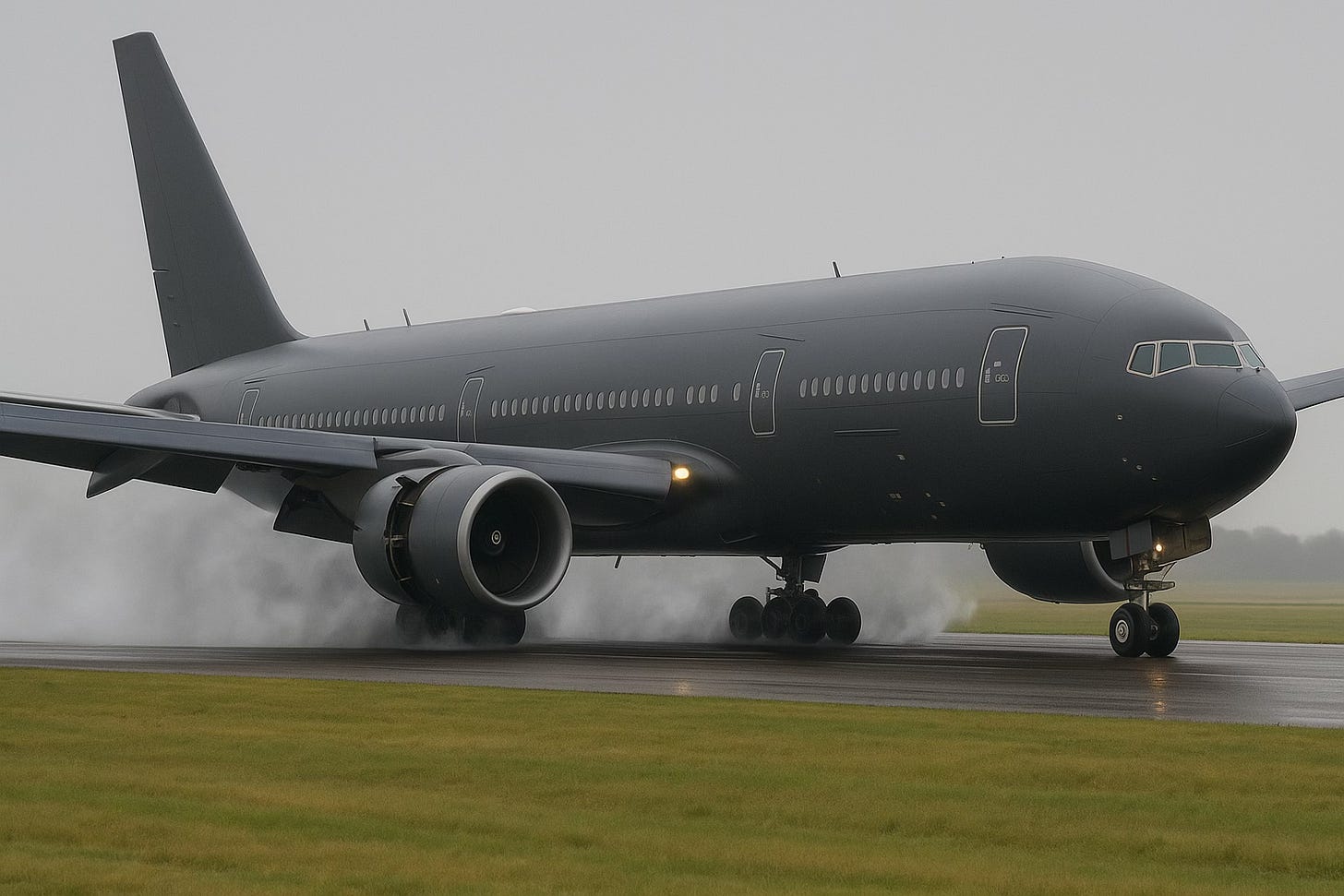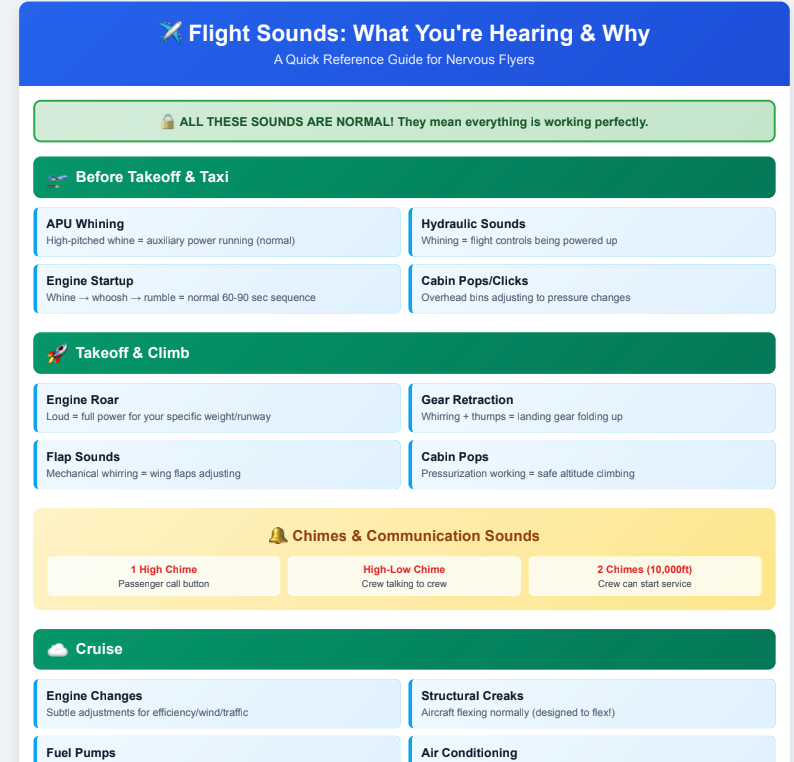Heard That Noise on the Plane? A Nervous Flyer's Guide to Aircraft Noises
A peaceful guide to the normal hums, clunks, and whirs that mean everything’s working just right. Bonus at the end.
If you're a nervous flyer, you know the feeling: you're settled into your seat when suddenly there's a loud clunk, a mechanical whirring, or a series of beeps from the cockpit. Your heart rate spikes as you wonder, "Is that normal?"
The truth is, modern aircraft are incredibly communicative machines. They're constantly talking to the pilots, the ground crew, and even the passengers through a symphony of purposeful sounds. Once you understand what you're hearing, these noises transform from sources of anxiety into reassuring signs that everything is working exactly as it should.
Before You Even Board: Ground Sounds
The APU (Auxiliary Power Unit) Whine That high-pitched whining sound you hear when approaching the aircraft? That's the APU essentially a small jet engine in the tail that provides power and air conditioning while the plane is parked.
Ground Equipment Beeping The various beeps and alarms you hear around the aircraft are usually from ground support equipment, baggage carts, fuel trucks, and ground power units. These vehicles are required to make noise when backing up or operating, just like construction equipment.
Boarding and Pre-Flight: The Cabin Comes Alive
Overhead Bin Clicks and Pops Those clicking sounds from above aren't the plane falling apart, they're the overhead bins expanding and contracting as the cabin pressurization system runs its pre-flight checks. The plastic interior adjusts to pressure changes, creating these harmless popping sounds.
Cockpit Chimes and Beeps Those chimes you hear throughout the flight are simply the crew's intercom system. All commercial aircraft have a cabin communication system - on Airbus aircraft, this is called CIDS (Cabin Intercommunication Data System). At every cabin crew station where the flight attendants sit, there's an interphone that allows cabin crew to communicate with each other, with the Senior Cabin Crew Member (SCCM), and with the flight crew. This system is also used for announcements.
On large aircraft, it would be impractical for cockpit crew to walk back to talk to flight attendants, or for flight attendants to walk the length of the cabin to communicate with each other about routine matters. Different chime patterns are like a quick "hey, pick up the phone" signal, each pattern tells the crew exactly who's calling and what type of communication it is.
For example, on common aircraft like the Airbus A320, the chime patterns work like this:
One high chime with a steady blue light means a passenger is calling from their seat
One high chime with steady amber light means a passenger is calling from the lavatory
One high-low chime with steady pink light means crew members are calling each other, the captain is calling the crew, or it's a conference call between all crew members
Variations by Aircraft Type Different aircraft models have their own unique chime sounds and light colors. Some Boeing 747s have a very distinctive low-high chime that repeats three times when the flight crew contacts the Senior Cabin Crew Member (SCCM). Wide-body Airbus aircraft might use a high-high-low chime for the same purpose. The light colors can vary too some Airbus A319 and A320 aircraft use green lights instead of pink, and the Boeing 787 also uses green lights. Older Boeing 737s had white lights and combinations of red and white lights for different calls.
The Special 10,000-Foot Chime One specific chime sequence you'll hear on most flights is two chimes that occur about 5-10 minutes after takeoff. This happens when the aircraft climbs through 10,000 feet, and it's the pilots' way of telling the cabin crew that the cockpit is no longer in what's called "sterile cockpit" mode. Below 10,000 feet, pilots focus exclusively on flying with minimal distractions, flight attendants won't call the cockpit unless there's a safety issue. Above 10,000 feet, normal communication can resume. Depending on airline procedures, this chime also usually signals that the cabin crew can begin their service routines. You'll notice that the pilots typically keep the fasten seatbelt sign on even after this chime, they still want passengers to remain seated while the aircraft continues climbing and may encounter turbulence, but the flight attendants can now start preparing for service.
Air Conditioning Whoosh That rushing air sound isn't a leak, it's the environmental control system working perfectly. The cabin air is completely replaced every 2-3 minutes with fresh, filtered air.
Pushback and Taxi: Getting Ready to Fly
Hydraulic Whining You might hear a high-pitched whining sound during various phases of flight – during pushback, after landing, or even after the engines shut down at the gate. This is the hydraulic system powering the flight controls, landing gear, and other systems. Hydraulics are what allow pilots to move the massive control surfaces, and that sound means they're working perfectly. On aircraft like the Airbus A320, you'll often hear this hydraulic pump sound continuing for several minutes even after the engines are turned off, this is completely normal.
Engine Startup Sequence Modern jet engines don't just "turn on", they go through a careful startup sequence. You'll hear the engine begin to whine, then a whooshing sound as fuel is introduced, followed by a deeper rumble as it reaches idle power. This process takes about 60-90 seconds per engine and sounds more dramatic than it is.
Ground Communication Static Those brief bursts of radio static you might hear are normal communications between the pilots and ground control. The volume is usually turned down, but you might catch fragments during taxi.
Takeoff: Power and Precision
Engine Spool-Up When the pilots advance the throttles for takeoff, you'll hear the engines change from a steady hum to a powerful roar. This increase in sound means the engines are producing the exact amount of thrust needed for your specific aircraft weight and runway conditions.
Gear and Flap Sounds Just after takeoff, you'll hear a series of mechanical sounds, whirring, clicking, and thumping. This is the landing gear retracting and the flaps adjusting. The landing gear doors close with a definitive thump, and the hydraulic systems make whirring sounds as they position everything for flight.
Pressurization Pops As you climb, your ears might pop, and you might hear occasional creaking or popping sounds from the cabin structure. This is the fuselage adjusting to the pressure differential between inside and outside the aircraft, a sign that the pressurization system is working correctly.
Cruise: The Quietest Phase
Occasional Engine Changes During cruise, you might notice subtle changes in engine sound. Pilots regularly make small adjustments for fuel efficiency, wind conditions, or air traffic control requirements. These changes are routine and planned.
Structural Creaking Like any structure, aircraft flex slightly in response to air currents and temperature changes. The occasional creak or pop is the aircraft's way of handling these forces – it's designed to flex, which actually makes it stronger and safer.
Descent and Landing: Controlled Complexity
Engine Power Reduction As you begin descent, the engines will reduce power significantly. This dramatic change in sound is normal – pilots are using the aircraft's momentum and letting gravity help with the descent.
Flap and Slat Extension You'll hear a series of mechanical sounds as the wing flaps and slats extend to increase lift at slower speeds. Each setting change comes with its own distinctive sound – whirring motors, clicking locks, and rushing air over the new wing configuration.
Autopilot Disconnect During the approach, you might hear a distinctive beeping sound from the cockpit, often two or three sharp beeps. This is the sound of the autopilot being disconnected as the pilot takes manual control for landing. It's a completely routine part of the approach procedure and simply means the pilot is now flying the aircraft by hand for the final phase of flight.
Landing Gear Extension About 7-5 minutes before landing, you'll hear the landing gear extend. This creates a significant thump, followed by rushing air sounds as the gear doors open and the wheels drop into position.
Reverse Thrust After touchdown, you might hear a loud roaring sound that seems to come from the wrong direction. This is reverse thrust, the engines are literally redirecting their power forward to help slow the aircraft. It sounds dramatic but it's a routine part of landing.
Special Sounds: Less Common but Still Normal
Cargo Door Sounds After landing, you might hear banging or mechanical sounds from below. This is ground crew opening cargo doors and unloading baggage – nothing to do with flight safety.
The Most Important Sound: Silence
Interestingly, one of the most reassuring sounds on an aircraft is the absence of certain sounds. You won't hear:
Warning bells or alarms (unless there's an actual issue requiring attention)
Grinding or scraping sounds (which would indicate a real problem)
Irregular engine rhythms (engines run incredibly smoothly)
Your New Perspective
The next time you fly, try listening to these sounds with your new knowledge. Instead of sources of anxiety, they become a reassuring soundtrack of systems working exactly as designed. Every sound has been anticipated, planned for, and approved by aviation authorities around the world.
Remember: if there were actually a problem, the flight crew would know immediately and would take appropriate action. The sounds you hear are the sounds of safety, engineering, and precision working together to get you safely to your destination.
Modern aircraft undergo thousands of hours of testing, and every sound they make has been heard, analyzed, and approved. So the next time you hear that mysterious whirring or clicking, you can sit back, relax, and appreciate the incredible technology that's taking care of you at 35,000 feet.
One Final Note: Every Aircraft Has Its Own Voice
Remember that every aircraft type, Boeing 737, Airbus A320, regional jets has its own particular sounds and quirks. Even individual aircraft of the same model can sound slightly different based on their age, maintenance history, and specific configuration. So don't be surprised if you hear something new on your next flight that wasn't covered here.
🎁 Want a calm companion on your next flight?
Download the FREE Flight Sounds Reference Guide HERE a simple infographic you can keep on your phone or print out. It explains what those chimes and noises mean, so you're never left wondering midair, or the Aircraft Chimes Decoded HERE
If you ever hear a sound that makes you curious or concerned, don't hesitate to ask your cabin crew about it. Simply press your call button or catch a flight attendant during service and say, "I'm a bit anxious about flying, could you tell me what that sound was?" They hear this question regularly and are always happy to explain. Flight attendants are trained to recognize all normal aircraft sounds and can quickly reassure you about what you're hearing. They've helped countless nervous flyers, and your question won't surprise them at all.
Safe travels, and remember – those sounds are the sound of everything working perfectly.
Pilot Nick



